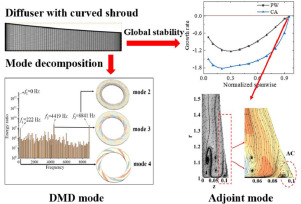当前位置:
X-MOL 学术
›
Int. J. Mech. Sci.
›
论文详情
Our official English website, www.x-mol.net, welcomes your
feedback! (Note: you will need to create a separate account there.)
Influence of Shroud Profiling on the Compressor Diffuser: Frozen-Eddy Approach and Mode Decomposition
International Journal of Mechanical Sciences ( IF 7.1 ) Pub Date : 2020-07-01 , DOI: 10.1016/j.ijmecsci.2020.105623 Chenxing Hu , Ce Yang , Weilin Yi , Siyu Zheng , Runnan Zou , Mi Zhou
International Journal of Mechanical Sciences ( IF 7.1 ) Pub Date : 2020-07-01 , DOI: 10.1016/j.ijmecsci.2020.105623 Chenxing Hu , Ce Yang , Weilin Yi , Siyu Zheng , Runnan Zou , Mi Zhou

|
Abstract The stability prediction and unsteady-flow characteristic explanations of centrifugal compressors mostly focus on radial vaneless diffusers with parallel walls (PWs). However, vaneless diffusers with curved shroud profiling are more often adopted in a practical compression system owing to their better performance or larger stability margin. In this work, the stability properties of the unsteady flow in the radial vaneless diffusers with parallel walls and curved shroud profiling were studied in the context of numerical simulations and global modes. First, the unsteady simulations of a full annular compressor, including vaneless diffusers with parallel walls and constant area walls, were carried out. The simulation results were validated against experimental data, and the dominant modes of the diffuser flow under stall conditions were captured using dynamic mode decomposition (DMD) analysis. Then, a frozen eddy stability analysis was performed on the vaneless diffusers, and the global mode associated with the flow perturbations was investigated. Finally, a continuous adjoint method was adopted to reveal the receptivity of the instability perturbations. By focusing on the effect of the curved shroud profiling on the stability characteristics, the global and adjoint eigenmodes corresponding to the onset of instability were used to provide a physical explanation for the stall mechanism. The simulation results indicated that the stability margin for diffuser with constant area walls was 2.15% wider than that with PWs. The DMD and global stability-analysis results showed that the diffuser with constant area walls had a stall frequency of 298 Hz, which was larger than that of diffuser with PWs. But both cases shared the same stall number of 4. The value of growth rate came to its minimum at 30% span and maximum at 95% span in both cases, indicating the dominant flow fields were near the shroud walls. For the vaneless diffuser with PWs, the reverse flow at 95% span within the radius range of r = 1.3–1.4 was the dominant reason for the occurrence of instability with large value of direct and adjoint mode. Meanwhile, flow mode indicated that flow instability of the diffuser with constant area walls was caused by the reverse flow at 90% span with the radius range of r = 1.02–1.1.
中文翻译:

护罩轮廓对压缩机扩散器的影响:冷冻涡流方法和模式分解
摘要 离心压缩机的稳定性预测和非定常流动特性解释主要集中在平行壁径向无叶扩压器(PWs)上。然而,由于其更好的性能或更大的稳定性裕度,在实际压缩系统中更常采用具有弯曲护罩轮廓的无叶片扩压器。在这项工作中,在数值模拟和全局模式的背景下,研究了具有平行壁和弯曲护罩轮廓的径向无叶片扩压器中不稳定流动的稳定性特性。首先,进行了全环形压缩机的非稳态模拟,包括具有平行壁和恒定面积壁的无叶片扩压器。模拟结果与实验数据进行了验证,并且使用动态模式分解 (DMD) 分析捕获失速条件下扩散器流动的主要模式。然后,对无叶片扩压器进行了冻结涡稳定性分析,并研究了与流动扰动相关的全局模式。最后,采用连续伴随方法来揭示不稳定扰动的接受度。通过关注弯曲护罩轮廓对稳定性特性的影响,使用与不稳定开始相对应的全局和伴随特征模态来为失速机制提供物理解释。模拟结果表明,具有恒定面积壁的扩散器的稳定性裕度比具有 PW 的扩散器宽 2.15%。DMD 和全局稳定性分析结果表明,具有恒定面积壁的扩散器的失速频率为 298 Hz,大于具有 PW 的扩散器的失速频率。但两种情况的失速数相同,均为 4。增长率在 30% 跨度时达到最小值,在 95% 跨度时达到最大值,表明主导流场位于围壁附近。对于带 PW 的无叶扩压器,在 r = 1.3-1.4 的半径范围内,95% 跨度处的反向流动是直接和伴随模式值较大时出现不稳定的主要原因。同时,流动模式表明,具有恒定面积壁的扩散器的流动不稳定是由半径范围为 r = 1.02-1.1 的 90% 跨度的反向流动引起的。但两种情况的失速数相同,均为 4。增长率在 30% 跨度时达到最小值,在 95% 跨度时达到最大值,表明主导流场位于围壁附近。对于带 PW 的无叶扩压器,在 r = 1.3-1.4 半径范围内 95% 跨度处的反向流动是出现大值直接和伴随模式不稳定的主要原因。同时,流动模式表明,具有恒定面积壁的扩散器的流动不稳定是由半径范围为 r = 1.02-1.1 的 90% 跨度的反向流动引起的。但两种情况的失速数相同,均为 4。增长率在 30% 跨度时达到最小值,在 95% 跨度时达到最大值,表明主导流场位于围壁附近。对于带 PW 的无叶扩压器,在 r = 1.3-1.4 半径范围内 95% 跨度处的反向流动是出现大值直接和伴随模式不稳定的主要原因。同时,流动模式表明,具有恒定面积壁的扩散器的流动不稳定是由半径范围为 r = 1.02-1.1 的 90% 跨度的反向流动引起的。r = 1.3-1.4半径范围内95%跨度处的反向流动是直接和伴随模态值较大的不稳定发生的主要原因。同时,流动模式表明,具有恒定面积壁的扩散器的流动不稳定是由半径范围为 r = 1.02-1.1 的 90% 跨度的反向流动引起的。r = 1.3-1.4半径范围内95%跨度处的反向流动是直接和伴随模态值较大的不稳定发生的主要原因。同时,流动模式表明,具有恒定面积壁的扩散器的流动不稳定是由半径范围为 r = 1.02-1.1 的 90% 跨度的反向流动引起的。
更新日期:2020-07-01
中文翻译:

护罩轮廓对压缩机扩散器的影响:冷冻涡流方法和模式分解
摘要 离心压缩机的稳定性预测和非定常流动特性解释主要集中在平行壁径向无叶扩压器(PWs)上。然而,由于其更好的性能或更大的稳定性裕度,在实际压缩系统中更常采用具有弯曲护罩轮廓的无叶片扩压器。在这项工作中,在数值模拟和全局模式的背景下,研究了具有平行壁和弯曲护罩轮廓的径向无叶片扩压器中不稳定流动的稳定性特性。首先,进行了全环形压缩机的非稳态模拟,包括具有平行壁和恒定面积壁的无叶片扩压器。模拟结果与实验数据进行了验证,并且使用动态模式分解 (DMD) 分析捕获失速条件下扩散器流动的主要模式。然后,对无叶片扩压器进行了冻结涡稳定性分析,并研究了与流动扰动相关的全局模式。最后,采用连续伴随方法来揭示不稳定扰动的接受度。通过关注弯曲护罩轮廓对稳定性特性的影响,使用与不稳定开始相对应的全局和伴随特征模态来为失速机制提供物理解释。模拟结果表明,具有恒定面积壁的扩散器的稳定性裕度比具有 PW 的扩散器宽 2.15%。DMD 和全局稳定性分析结果表明,具有恒定面积壁的扩散器的失速频率为 298 Hz,大于具有 PW 的扩散器的失速频率。但两种情况的失速数相同,均为 4。增长率在 30% 跨度时达到最小值,在 95% 跨度时达到最大值,表明主导流场位于围壁附近。对于带 PW 的无叶扩压器,在 r = 1.3-1.4 的半径范围内,95% 跨度处的反向流动是直接和伴随模式值较大时出现不稳定的主要原因。同时,流动模式表明,具有恒定面积壁的扩散器的流动不稳定是由半径范围为 r = 1.02-1.1 的 90% 跨度的反向流动引起的。但两种情况的失速数相同,均为 4。增长率在 30% 跨度时达到最小值,在 95% 跨度时达到最大值,表明主导流场位于围壁附近。对于带 PW 的无叶扩压器,在 r = 1.3-1.4 半径范围内 95% 跨度处的反向流动是出现大值直接和伴随模式不稳定的主要原因。同时,流动模式表明,具有恒定面积壁的扩散器的流动不稳定是由半径范围为 r = 1.02-1.1 的 90% 跨度的反向流动引起的。但两种情况的失速数相同,均为 4。增长率在 30% 跨度时达到最小值,在 95% 跨度时达到最大值,表明主导流场位于围壁附近。对于带 PW 的无叶扩压器,在 r = 1.3-1.4 半径范围内 95% 跨度处的反向流动是出现大值直接和伴随模式不稳定的主要原因。同时,流动模式表明,具有恒定面积壁的扩散器的流动不稳定是由半径范围为 r = 1.02-1.1 的 90% 跨度的反向流动引起的。r = 1.3-1.4半径范围内95%跨度处的反向流动是直接和伴随模态值较大的不稳定发生的主要原因。同时,流动模式表明,具有恒定面积壁的扩散器的流动不稳定是由半径范围为 r = 1.02-1.1 的 90% 跨度的反向流动引起的。r = 1.3-1.4半径范围内95%跨度处的反向流动是直接和伴随模态值较大的不稳定发生的主要原因。同时,流动模式表明,具有恒定面积壁的扩散器的流动不稳定是由半径范围为 r = 1.02-1.1 的 90% 跨度的反向流动引起的。











































 京公网安备 11010802027423号
京公网安备 11010802027423号